The Ethical and Practical Implications of Cloning Technologies
VerifiedAdded on 2020/05/11
|7
|1881
|328
AI Summary
The study of cloning has progressed significantly since the cloning of Dolly the sheep, with advancements suggesting the possibility of designing any organism from simple organisms to potentially humans. Cloning reduces time for creating transgenic models and offers solutions like stem cell therapies for rare diseases. It also presents opportunities in resurrecting extinct species, aiding biodiversity restoration. However, human cloning raises significant ethical concerns related to embryo health, sex determination, human rights, and the reduction of human capabilities. Despite its potential benefits, these issues necessitate careful consideration before advancing cloning technologies.
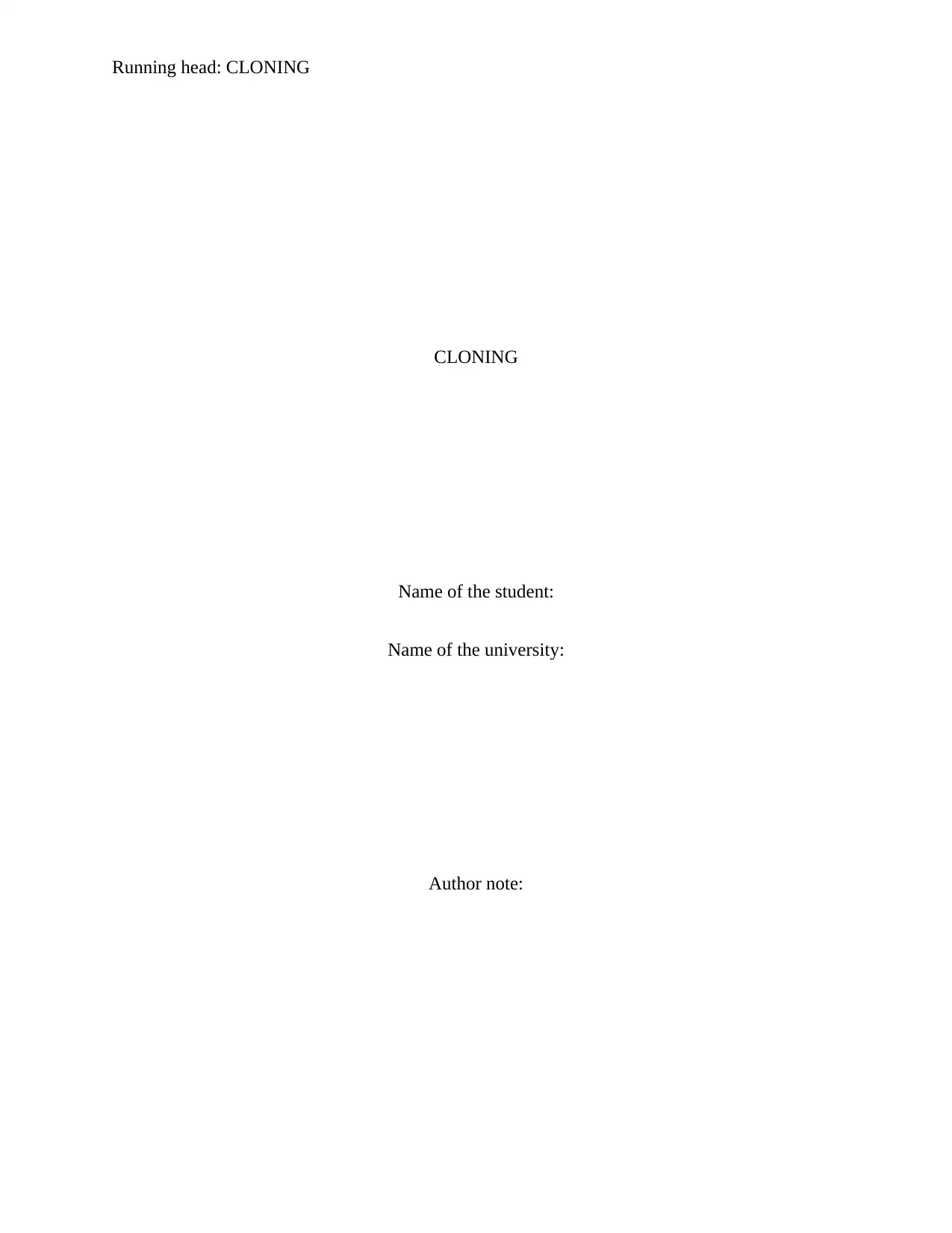
Running head: CLONING
CLONING
Name of the student:
Name of the university:
Author note:
CLONING
Name of the student:
Name of the university:
Author note:
Paraphrase This Document
Need a fresh take? Get an instant paraphrase of this document with our AI Paraphraser

1
CLONING
Cloning can be defined as the process by which exact identical copies or organisms can
be prepared. Clones are these organisms which have exactly same copies. They are done with the
help of asexually reproducing bacteria who help in producing several copies of the same mother
DNA (Brown, 2016). This can then be inserted in egg for normal development of organisms or
other techniques can be also performed to produce individuals artificially. This is quite an
interesting topic for me as humans have garnered the power of producing new lives without the
help of the almighty by following exceptional innovative way inside the laboratory itself.
For a large number of years from 1958 to 1996, transfer of the donor nuclei from cells
present in the early embryos were carried out to develop new cells with the help of egg cells in
the receiver. During this time, scientists discovered that cells can be at first modified and then
they can undertake the nucleic transfer process to produce new organisms. However all these
were done from embryonic stages until 277 experiments were carried out in 1996 and one of
them produced Dolly which is a successful clone of an entire organism (Engler et al. 2014). The
main exceptional feature that needs to be noted was that this experiment showed that
differentiated adult cell can also be used to produce organisms successfully. Usually embryonic
cells can activate any gene but differentiated adult cells cannot do so as their genetic information
needed to be reset to embryonic stage. This reset process remain incomplete usually but in case
of dolly, it somehow clocked and dolly was born.
Cloning has a proper relationship with biochemistry. When a clone is produced by
mitosis, genetic content of the newer cell is identical to the older cell as the cell remains derived
from single ancestor cell. As the process is related with reproduction procedures of animals, it
CLONING
Cloning can be defined as the process by which exact identical copies or organisms can
be prepared. Clones are these organisms which have exactly same copies. They are done with the
help of asexually reproducing bacteria who help in producing several copies of the same mother
DNA (Brown, 2016). This can then be inserted in egg for normal development of organisms or
other techniques can be also performed to produce individuals artificially. This is quite an
interesting topic for me as humans have garnered the power of producing new lives without the
help of the almighty by following exceptional innovative way inside the laboratory itself.
For a large number of years from 1958 to 1996, transfer of the donor nuclei from cells
present in the early embryos were carried out to develop new cells with the help of egg cells in
the receiver. During this time, scientists discovered that cells can be at first modified and then
they can undertake the nucleic transfer process to produce new organisms. However all these
were done from embryonic stages until 277 experiments were carried out in 1996 and one of
them produced Dolly which is a successful clone of an entire organism (Engler et al. 2014). The
main exceptional feature that needs to be noted was that this experiment showed that
differentiated adult cell can also be used to produce organisms successfully. Usually embryonic
cells can activate any gene but differentiated adult cells cannot do so as their genetic information
needed to be reset to embryonic stage. This reset process remain incomplete usually but in case
of dolly, it somehow clocked and dolly was born.
Cloning has a proper relationship with biochemistry. When a clone is produced by
mitosis, genetic content of the newer cell is identical to the older cell as the cell remains derived
from single ancestor cell. As the process is related with reproduction procedures of animals, it
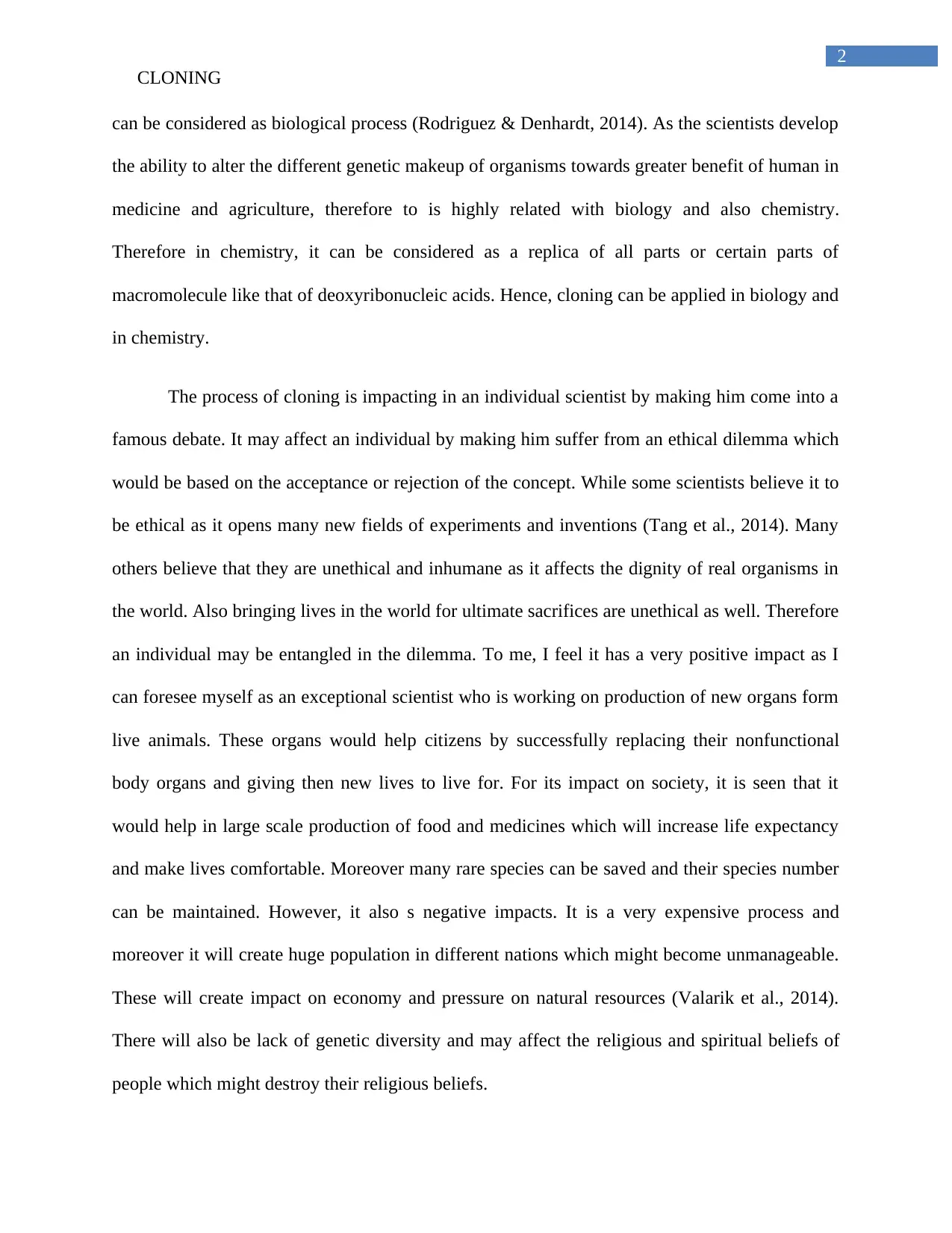
2
CLONING
can be considered as biological process (Rodriguez & Denhardt, 2014). As the scientists develop
the ability to alter the different genetic makeup of organisms towards greater benefit of human in
medicine and agriculture, therefore to is highly related with biology and also chemistry.
Therefore in chemistry, it can be considered as a replica of all parts or certain parts of
macromolecule like that of deoxyribonucleic acids. Hence, cloning can be applied in biology and
in chemistry.
The process of cloning is impacting in an individual scientist by making him come into a
famous debate. It may affect an individual by making him suffer from an ethical dilemma which
would be based on the acceptance or rejection of the concept. While some scientists believe it to
be ethical as it opens many new fields of experiments and inventions (Tang et al., 2014). Many
others believe that they are unethical and inhumane as it affects the dignity of real organisms in
the world. Also bringing lives in the world for ultimate sacrifices are unethical as well. Therefore
an individual may be entangled in the dilemma. To me, I feel it has a very positive impact as I
can foresee myself as an exceptional scientist who is working on production of new organs form
live animals. These organs would help citizens by successfully replacing their nonfunctional
body organs and giving then new lives to live for. For its impact on society, it is seen that it
would help in large scale production of food and medicines which will increase life expectancy
and make lives comfortable. Moreover many rare species can be saved and their species number
can be maintained. However, it also s negative impacts. It is a very expensive process and
moreover it will create huge population in different nations which might become unmanageable.
These will create impact on economy and pressure on natural resources (Valarik et al., 2014).
There will also be lack of genetic diversity and may affect the religious and spiritual beliefs of
people which might destroy their religious beliefs.
CLONING
can be considered as biological process (Rodriguez & Denhardt, 2014). As the scientists develop
the ability to alter the different genetic makeup of organisms towards greater benefit of human in
medicine and agriculture, therefore to is highly related with biology and also chemistry.
Therefore in chemistry, it can be considered as a replica of all parts or certain parts of
macromolecule like that of deoxyribonucleic acids. Hence, cloning can be applied in biology and
in chemistry.
The process of cloning is impacting in an individual scientist by making him come into a
famous debate. It may affect an individual by making him suffer from an ethical dilemma which
would be based on the acceptance or rejection of the concept. While some scientists believe it to
be ethical as it opens many new fields of experiments and inventions (Tang et al., 2014). Many
others believe that they are unethical and inhumane as it affects the dignity of real organisms in
the world. Also bringing lives in the world for ultimate sacrifices are unethical as well. Therefore
an individual may be entangled in the dilemma. To me, I feel it has a very positive impact as I
can foresee myself as an exceptional scientist who is working on production of new organs form
live animals. These organs would help citizens by successfully replacing their nonfunctional
body organs and giving then new lives to live for. For its impact on society, it is seen that it
would help in large scale production of food and medicines which will increase life expectancy
and make lives comfortable. Moreover many rare species can be saved and their species number
can be maintained. However, it also s negative impacts. It is a very expensive process and
moreover it will create huge population in different nations which might become unmanageable.
These will create impact on economy and pressure on natural resources (Valarik et al., 2014).
There will also be lack of genetic diversity and may affect the religious and spiritual beliefs of
people which might destroy their religious beliefs.
⊘ This is a preview!⊘
Do you want full access?
Subscribe today to unlock all pages.

Trusted by 1+ million students worldwide
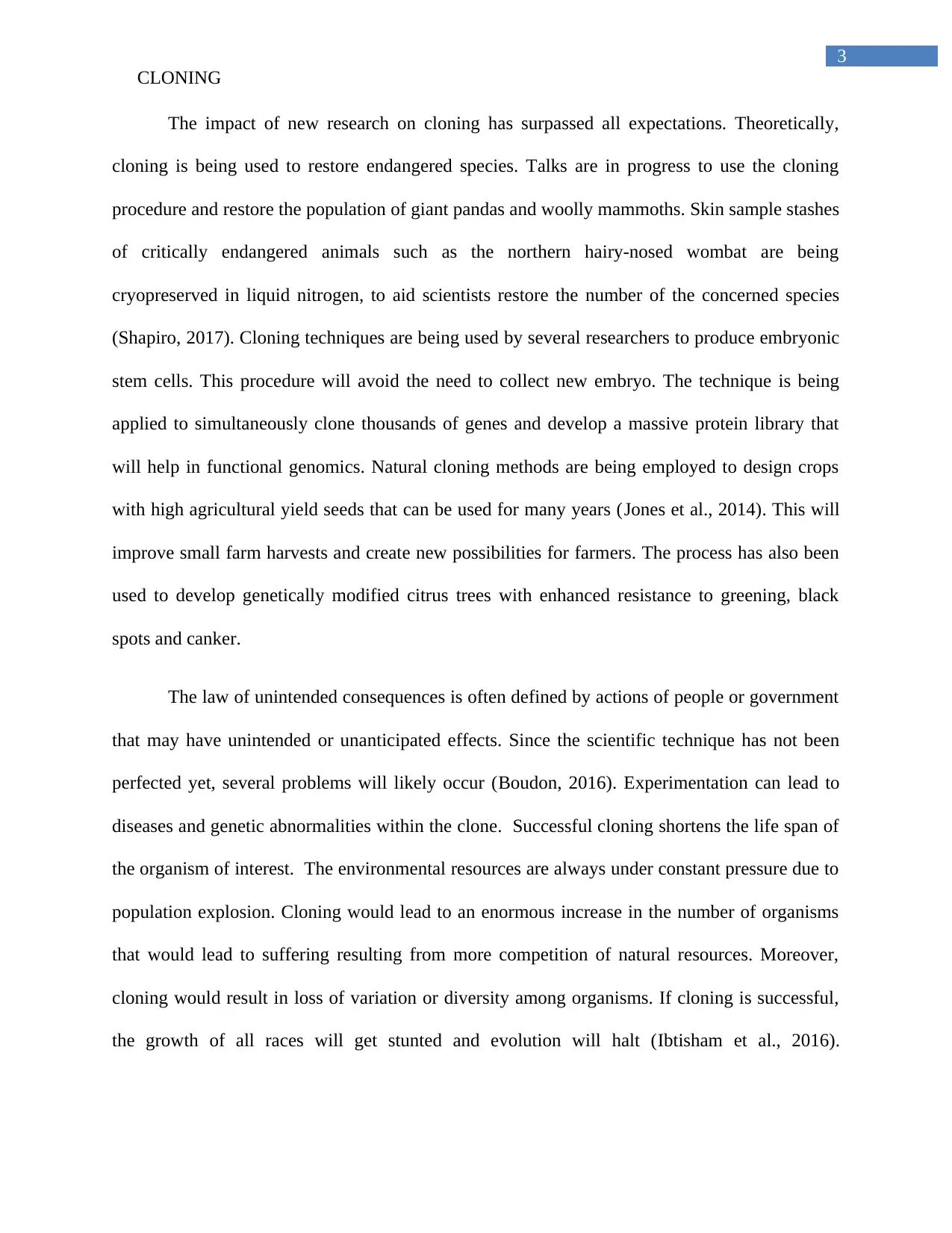
3
CLONING
The impact of new research on cloning has surpassed all expectations. Theoretically,
cloning is being used to restore endangered species. Talks are in progress to use the cloning
procedure and restore the population of giant pandas and woolly mammoths. Skin sample stashes
of critically endangered animals such as the northern hairy-nosed wombat are being
cryopreserved in liquid nitrogen, to aid scientists restore the number of the concerned species
(Shapiro, 2017). Cloning techniques are being used by several researchers to produce embryonic
stem cells. This procedure will avoid the need to collect new embryo. The technique is being
applied to simultaneously clone thousands of genes and develop a massive protein library that
will help in functional genomics. Natural cloning methods are being employed to design crops
with high agricultural yield seeds that can be used for many years (Jones et al., 2014). This will
improve small farm harvests and create new possibilities for farmers. The process has also been
used to develop genetically modified citrus trees with enhanced resistance to greening, black
spots and canker.
The law of unintended consequences is often defined by actions of people or government
that may have unintended or unanticipated effects. Since the scientific technique has not been
perfected yet, several problems will likely occur (Boudon, 2016). Experimentation can lead to
diseases and genetic abnormalities within the clone. Successful cloning shortens the life span of
the organism of interest. The environmental resources are always under constant pressure due to
population explosion. Cloning would lead to an enormous increase in the number of organisms
that would lead to suffering resulting from more competition of natural resources. Moreover,
cloning would result in loss of variation or diversity among organisms. If cloning is successful,
the growth of all races will get stunted and evolution will halt (Ibtisham et al., 2016).
CLONING
The impact of new research on cloning has surpassed all expectations. Theoretically,
cloning is being used to restore endangered species. Talks are in progress to use the cloning
procedure and restore the population of giant pandas and woolly mammoths. Skin sample stashes
of critically endangered animals such as the northern hairy-nosed wombat are being
cryopreserved in liquid nitrogen, to aid scientists restore the number of the concerned species
(Shapiro, 2017). Cloning techniques are being used by several researchers to produce embryonic
stem cells. This procedure will avoid the need to collect new embryo. The technique is being
applied to simultaneously clone thousands of genes and develop a massive protein library that
will help in functional genomics. Natural cloning methods are being employed to design crops
with high agricultural yield seeds that can be used for many years (Jones et al., 2014). This will
improve small farm harvests and create new possibilities for farmers. The process has also been
used to develop genetically modified citrus trees with enhanced resistance to greening, black
spots and canker.
The law of unintended consequences is often defined by actions of people or government
that may have unintended or unanticipated effects. Since the scientific technique has not been
perfected yet, several problems will likely occur (Boudon, 2016). Experimentation can lead to
diseases and genetic abnormalities within the clone. Successful cloning shortens the life span of
the organism of interest. The environmental resources are always under constant pressure due to
population explosion. Cloning would lead to an enormous increase in the number of organisms
that would lead to suffering resulting from more competition of natural resources. Moreover,
cloning would result in loss of variation or diversity among organisms. If cloning is successful,
the growth of all races will get stunted and evolution will halt (Ibtisham et al., 2016).
Paraphrase This Document
Need a fresh take? Get an instant paraphrase of this document with our AI Paraphraser
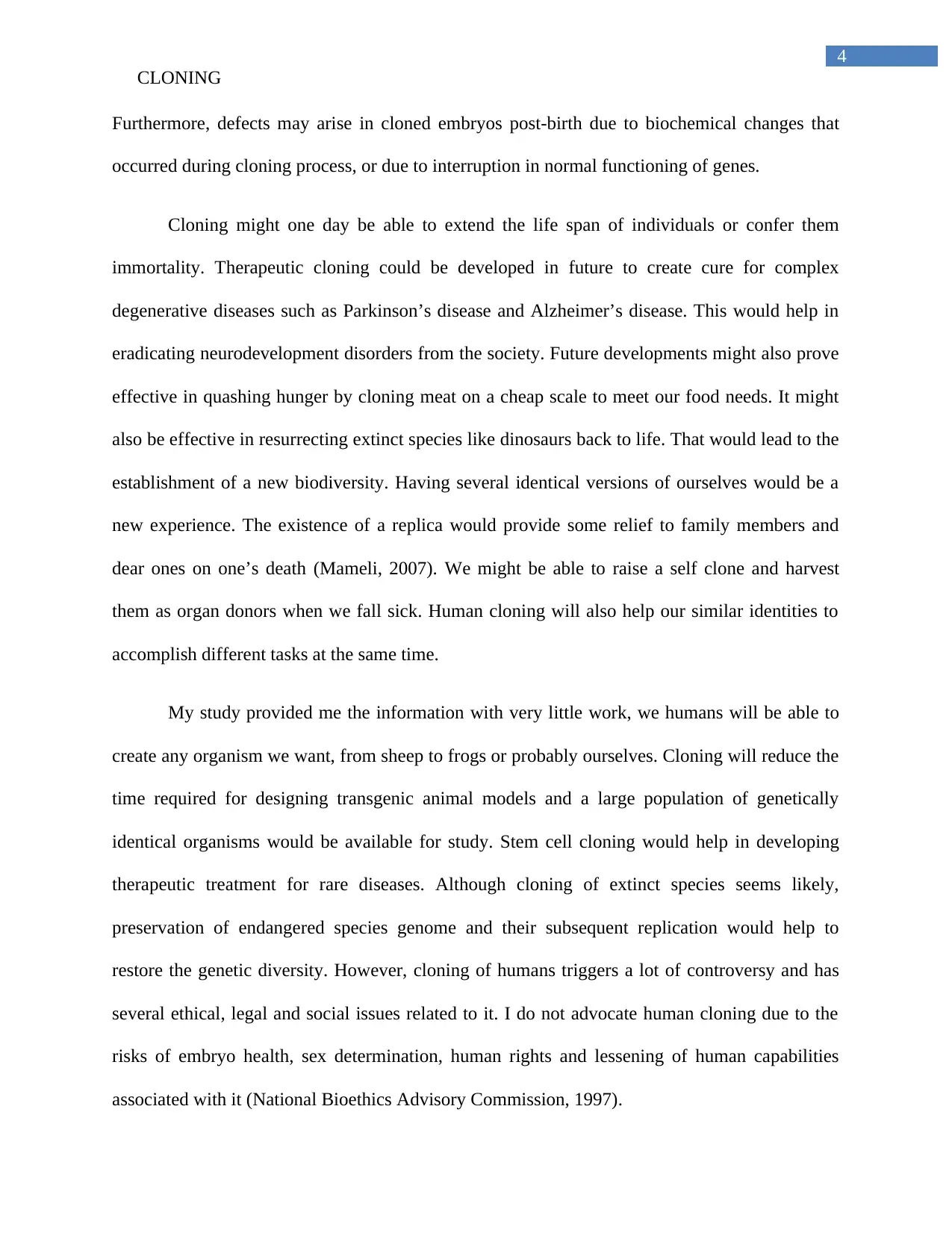
4
CLONING
Furthermore, defects may arise in cloned embryos post-birth due to biochemical changes that
occurred during cloning process, or due to interruption in normal functioning of genes.
Cloning might one day be able to extend the life span of individuals or confer them
immortality. Therapeutic cloning could be developed in future to create cure for complex
degenerative diseases such as Parkinson’s disease and Alzheimer’s disease. This would help in
eradicating neurodevelopment disorders from the society. Future developments might also prove
effective in quashing hunger by cloning meat on a cheap scale to meet our food needs. It might
also be effective in resurrecting extinct species like dinosaurs back to life. That would lead to the
establishment of a new biodiversity. Having several identical versions of ourselves would be a
new experience. The existence of a replica would provide some relief to family members and
dear ones on one’s death (Mameli, 2007). We might be able to raise a self clone and harvest
them as organ donors when we fall sick. Human cloning will also help our similar identities to
accomplish different tasks at the same time.
My study provided me the information with very little work, we humans will be able to
create any organism we want, from sheep to frogs or probably ourselves. Cloning will reduce the
time required for designing transgenic animal models and a large population of genetically
identical organisms would be available for study. Stem cell cloning would help in developing
therapeutic treatment for rare diseases. Although cloning of extinct species seems likely,
preservation of endangered species genome and their subsequent replication would help to
restore the genetic diversity. However, cloning of humans triggers a lot of controversy and has
several ethical, legal and social issues related to it. I do not advocate human cloning due to the
risks of embryo health, sex determination, human rights and lessening of human capabilities
associated with it (National Bioethics Advisory Commission, 1997).
CLONING
Furthermore, defects may arise in cloned embryos post-birth due to biochemical changes that
occurred during cloning process, or due to interruption in normal functioning of genes.
Cloning might one day be able to extend the life span of individuals or confer them
immortality. Therapeutic cloning could be developed in future to create cure for complex
degenerative diseases such as Parkinson’s disease and Alzheimer’s disease. This would help in
eradicating neurodevelopment disorders from the society. Future developments might also prove
effective in quashing hunger by cloning meat on a cheap scale to meet our food needs. It might
also be effective in resurrecting extinct species like dinosaurs back to life. That would lead to the
establishment of a new biodiversity. Having several identical versions of ourselves would be a
new experience. The existence of a replica would provide some relief to family members and
dear ones on one’s death (Mameli, 2007). We might be able to raise a self clone and harvest
them as organ donors when we fall sick. Human cloning will also help our similar identities to
accomplish different tasks at the same time.
My study provided me the information with very little work, we humans will be able to
create any organism we want, from sheep to frogs or probably ourselves. Cloning will reduce the
time required for designing transgenic animal models and a large population of genetically
identical organisms would be available for study. Stem cell cloning would help in developing
therapeutic treatment for rare diseases. Although cloning of extinct species seems likely,
preservation of endangered species genome and their subsequent replication would help to
restore the genetic diversity. However, cloning of humans triggers a lot of controversy and has
several ethical, legal and social issues related to it. I do not advocate human cloning due to the
risks of embryo health, sex determination, human rights and lessening of human capabilities
associated with it (National Bioethics Advisory Commission, 1997).
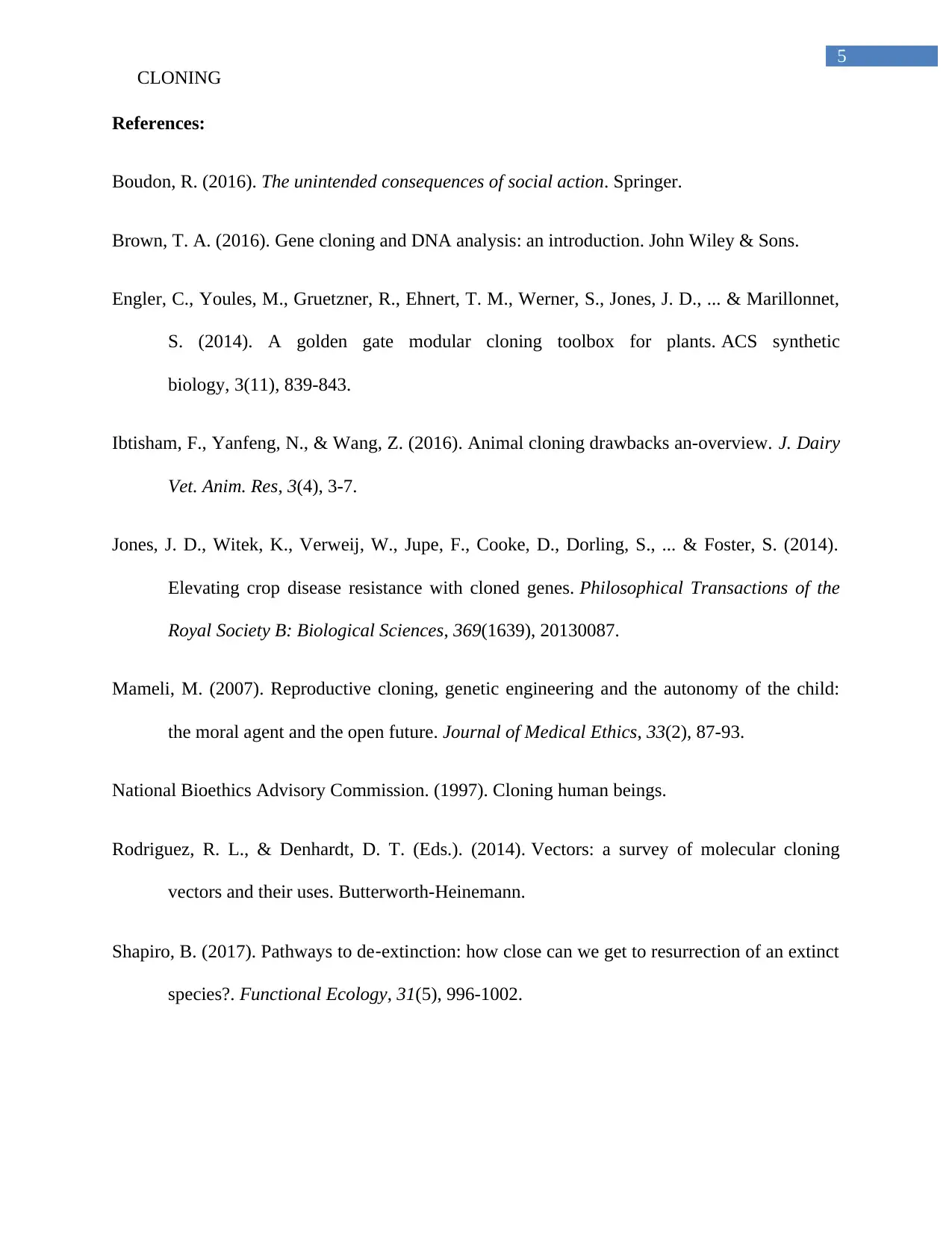
5
CLONING
References:
Boudon, R. (2016). The unintended consequences of social action. Springer.
Brown, T. A. (2016). Gene cloning and DNA analysis: an introduction. John Wiley & Sons.
Engler, C., Youles, M., Gruetzner, R., Ehnert, T. M., Werner, S., Jones, J. D., ... & Marillonnet,
S. (2014). A golden gate modular cloning toolbox for plants. ACS synthetic
biology, 3(11), 839-843.
Ibtisham, F., Yanfeng, N., & Wang, Z. (2016). Animal cloning drawbacks an-overview. J. Dairy
Vet. Anim. Res, 3(4), 3-7.
Jones, J. D., Witek, K., Verweij, W., Jupe, F., Cooke, D., Dorling, S., ... & Foster, S. (2014).
Elevating crop disease resistance with cloned genes. Philosophical Transactions of the
Royal Society B: Biological Sciences, 369(1639), 20130087.
Mameli, M. (2007). Reproductive cloning, genetic engineering and the autonomy of the child:
the moral agent and the open future. Journal of Medical Ethics, 33(2), 87-93.
National Bioethics Advisory Commission. (1997). Cloning human beings.
Rodriguez, R. L., & Denhardt, D. T. (Eds.). (2014). Vectors: a survey of molecular cloning
vectors and their uses. Butterworth-Heinemann.
Shapiro, B. (2017). Pathways to de‐extinction: how close can we get to resurrection of an extinct
species?. Functional Ecology, 31(5), 996-1002.
CLONING
References:
Boudon, R. (2016). The unintended consequences of social action. Springer.
Brown, T. A. (2016). Gene cloning and DNA analysis: an introduction. John Wiley & Sons.
Engler, C., Youles, M., Gruetzner, R., Ehnert, T. M., Werner, S., Jones, J. D., ... & Marillonnet,
S. (2014). A golden gate modular cloning toolbox for plants. ACS synthetic
biology, 3(11), 839-843.
Ibtisham, F., Yanfeng, N., & Wang, Z. (2016). Animal cloning drawbacks an-overview. J. Dairy
Vet. Anim. Res, 3(4), 3-7.
Jones, J. D., Witek, K., Verweij, W., Jupe, F., Cooke, D., Dorling, S., ... & Foster, S. (2014).
Elevating crop disease resistance with cloned genes. Philosophical Transactions of the
Royal Society B: Biological Sciences, 369(1639), 20130087.
Mameli, M. (2007). Reproductive cloning, genetic engineering and the autonomy of the child:
the moral agent and the open future. Journal of Medical Ethics, 33(2), 87-93.
National Bioethics Advisory Commission. (1997). Cloning human beings.
Rodriguez, R. L., & Denhardt, D. T. (Eds.). (2014). Vectors: a survey of molecular cloning
vectors and their uses. Butterworth-Heinemann.
Shapiro, B. (2017). Pathways to de‐extinction: how close can we get to resurrection of an extinct
species?. Functional Ecology, 31(5), 996-1002.
⊘ This is a preview!⊘
Do you want full access?
Subscribe today to unlock all pages.

Trusted by 1+ million students worldwide
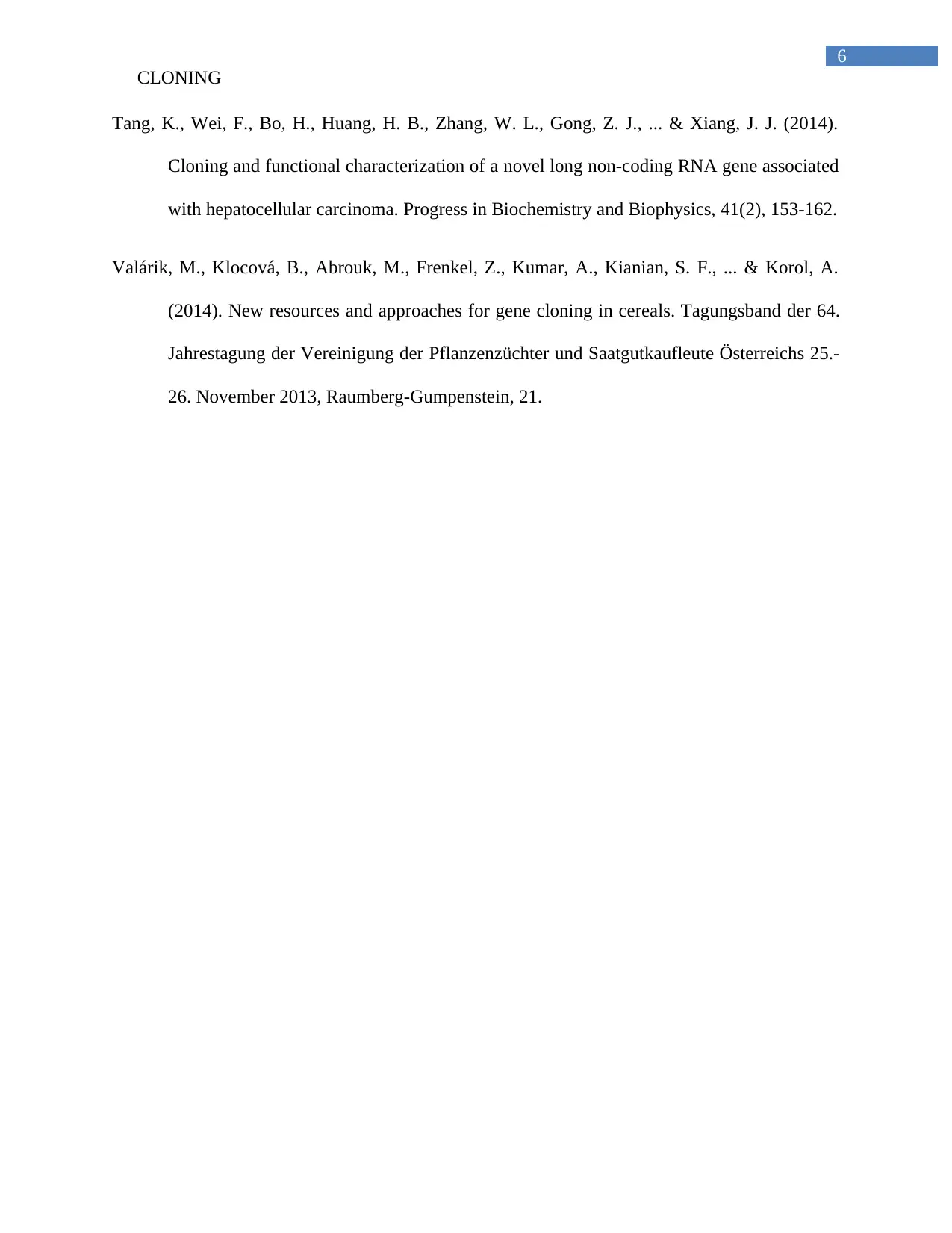
6
CLONING
Tang, K., Wei, F., Bo, H., Huang, H. B., Zhang, W. L., Gong, Z. J., ... & Xiang, J. J. (2014).
Cloning and functional characterization of a novel long non-coding RNA gene associated
with hepatocellular carcinoma. Progress in Biochemistry and Biophysics, 41(2), 153-162.
Valárik, M., Klocová, B., Abrouk, M., Frenkel, Z., Kumar, A., Kianian, S. F., ... & Korol, A.
(2014). New resources and approaches for gene cloning in cereals. Tagungsband der 64.
Jahrestagung der Vereinigung der Pflanzenzüchter und Saatgutkaufleute Österreichs 25.-
26. November 2013, Raumberg-Gumpenstein, 21.
CLONING
Tang, K., Wei, F., Bo, H., Huang, H. B., Zhang, W. L., Gong, Z. J., ... & Xiang, J. J. (2014).
Cloning and functional characterization of a novel long non-coding RNA gene associated
with hepatocellular carcinoma. Progress in Biochemistry and Biophysics, 41(2), 153-162.
Valárik, M., Klocová, B., Abrouk, M., Frenkel, Z., Kumar, A., Kianian, S. F., ... & Korol, A.
(2014). New resources and approaches for gene cloning in cereals. Tagungsband der 64.
Jahrestagung der Vereinigung der Pflanzenzüchter und Saatgutkaufleute Österreichs 25.-
26. November 2013, Raumberg-Gumpenstein, 21.
1 out of 7
Related Documents
Your All-in-One AI-Powered Toolkit for Academic Success.
+13062052269
info@desklib.com
Available 24*7 on WhatsApp / Email
![[object Object]](/_next/static/media/star-bottom.7253800d.svg)
Unlock your academic potential
Copyright © 2020–2025 A2Z Services. All Rights Reserved. Developed and managed by ZUCOL.




